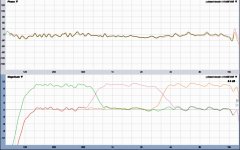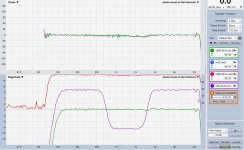Hi all, some may have seen in other threads that i often talk about having a separate volume control on each driver section, that can be adjusted underneath an overall volume control.
I do this for both loudness compensation, and for adjusting tonal balance of individual tracks which i find can vary like a politician, haha
Anyway, i believe the key to the happy results i've been getting with this technique, is how that changing relative SPL levels between driver sections doesn't effect phase.
Reason being, the xovers used are linear phase, and steep, which leaves little room for summation problems away from the xover freq.
Below is a quick set of measurements just taken from a 3-way, to show what I'm trying to explain.
Mid is 12" cone 120-650Hz. HF is coax CD 650-3.2kHz. VHF is coax CD 3.2kHz up.
All were 1/6th smoothing magnitude, 1/12th phase. Indoors in really noisy conditions, everybody home both🙂 + 🙁 lol,... and is why a sub wasn't brought into the test as well.
Here's the 3-way with all sections running at equal level.
Please note the level phase trace.
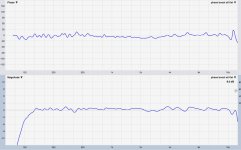
Here's with each of the 3 sections individually raised +10dB.
Please note the level phase traces !
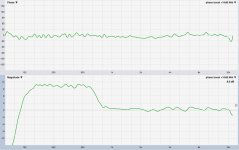
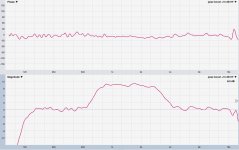
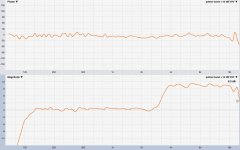
+10dB is obviously a hell of a lot of boost, likely to never be used.
But I've found many songs that can use +5dB on the sub, and -5dB on HF/ VHF. And that's on top of a medium downslope house curve.
The neat thing though, is it doesn't matter whether boosts or cuts are used, smiley face, frowny face, whatever,...it never sounds whacky like it can when trying to adjust tonal balance with normal EQs.
And it works so easily for almost every track encountered, at whatever volume.
fwiw...Just though some folks might be interested...
I do this for both loudness compensation, and for adjusting tonal balance of individual tracks which i find can vary like a politician, haha
Anyway, i believe the key to the happy results i've been getting with this technique, is how that changing relative SPL levels between driver sections doesn't effect phase.
Reason being, the xovers used are linear phase, and steep, which leaves little room for summation problems away from the xover freq.
Below is a quick set of measurements just taken from a 3-way, to show what I'm trying to explain.
Mid is 12" cone 120-650Hz. HF is coax CD 650-3.2kHz. VHF is coax CD 3.2kHz up.
All were 1/6th smoothing magnitude, 1/12th phase. Indoors in really noisy conditions, everybody home both🙂 + 🙁 lol,... and is why a sub wasn't brought into the test as well.
Here's the 3-way with all sections running at equal level.
Please note the level phase trace.

Here's with each of the 3 sections individually raised +10dB.
Please note the level phase traces !



+10dB is obviously a hell of a lot of boost, likely to never be used.
But I've found many songs that can use +5dB on the sub, and -5dB on HF/ VHF. And that's on top of a medium downslope house curve.
The neat thing though, is it doesn't matter whether boosts or cuts are used, smiley face, frowny face, whatever,...it never sounds whacky like it can when trying to adjust tonal balance with normal EQs.
And it works so easily for almost every track encountered, at whatever volume.
fwiw...Just though some folks might be interested...
Thanks Camplo, nice for making that overlay.
I had made one too, but thought folks might need to see the sections individually boosted, to believe them.
I had made one too, but thought folks might need to see the sections individually boosted, to believe them.
how about passing a 1KHz squarewave through this setup?
Ask and you shall receive 😀
Well, almost....i used a 200Hz square wave so that the Mid driver (120-650Hz) would also be in play.
This scope shot is with all three sections at same 0 dB drive level.
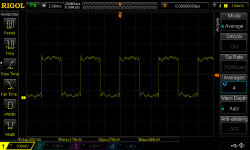
I had moved the speaker sections into a bedroom this morning for cleaner acoustic measurements, because I was curious to see how phase holds up under a more extreme boost and cut scenario.
(About to post the phase result next....)
Saw your post and said, hmm....I already know without measuring that a square wave will look pretty good with equal mag across the sections...even from an acoustic measurement.
But wondered how whacked it would look with the boost/cut tests I'm trying... so here it is with Mid +10 dB, HF -10dB, and VHF +10dB.
Not as whacked as I would have thought...a quick peak at higher frequencies got bizzare...but then again, no HF/VHF audio square wave ever looks good.
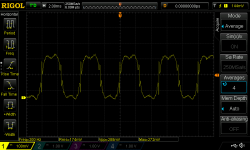
indoors? is this fir file flattened room response?
yes you can do it but is it necessary?
As was said, indoors and noisy.
Sure, i hoped it was pretty obvious it's fir flattened, since it's both mag and phase FLAT 😀
and the whole topic is about one of the benefits of lin phase xovers.
Is what necessary ?? you lost me.....
pc crossovers are very powerful.
i can do it as flat as that to one spot in room but if i move mic 1m aint flat anymore.
is this your rental set or just some laugh and gags set?
i can do it as flat as that to one spot in room but if i move mic 1m aint flat anymore.
is this your rental set or just some laugh and gags set?
Ok, thought i'd continue on with a more extreme boost and cut test, on the three driver sections after tuning via fir and using linear phase xovers.
I moved the speaker into a bedroom and quickly built tune-to-a-spot FIR files.
Repeating the Xovers: Mid 120-650; HF 650-3200, and VHF 3200 up.
96 dB/oct LR's.
The green trace is all three sections run at equal level, 0 dB.
The purple trace has the Mid and VHF sections each boosted 10dB,
with the HF section cut 10dB.
Mag is 1/12th smoothing (much cleaner in bedroom)
and phase has no smoothing.
As you can see, phase is unphazed 🙂 by the magnitude level changes between sections.
Like said, i find the degree of tonality sculpting that's available, without mucking up the sound, to be truly remarkable...
I moved the speaker into a bedroom and quickly built tune-to-a-spot FIR files.
Repeating the Xovers: Mid 120-650; HF 650-3200, and VHF 3200 up.
96 dB/oct LR's.
The green trace is all three sections run at equal level, 0 dB.
The purple trace has the Mid and VHF sections each boosted 10dB,
with the HF section cut 10dB.
Mag is 1/12th smoothing (much cleaner in bedroom)
and phase has no smoothing.
As you can see, phase is unphazed 🙂 by the magnitude level changes between sections.
Like said, i find the degree of tonality sculpting that's available, without mucking up the sound, to be truly remarkable...
Attachments
pc crossovers are very powerful.
i can do it as flat as that to one spot in room but if i move mic 1m aint flat anymore.
is this your rental set or just some laugh and gags set?
Everything is laugh and gags now....got out of the rental headache scene...
Yeah, tune to a spot means nothing any more ....to easy to do, and mostly too easy to do wrong.
But I have found the wider a coverage area i can keep the traces holding together, the better it sounds ...indoors or out.... in any room etc.
I don't use PC for dsp...all i have available is about 4k taps per channel @48kHz with prosound dsp
Hi billshurv,
No, not shelving filter(s) at all.
I simply have a volume control on each of the 3 driver sections.
The level changes, like +10, -10, +10....are done on the fly vs flat, with zero change in processing.
There are no added EQ's, shelving, anything at all. Just volume faders.
That's what's so cool about it i think, that much frequency response change and no effect on phase whatsoever.....
well, that and how natural it sounds, making tonal adjustments.
My ultimate tone control setup so far...🙂
No, not shelving filter(s) at all.
I simply have a volume control on each of the 3 driver sections.
The level changes, like +10, -10, +10....are done on the fly vs flat, with zero change in processing.
There are no added EQ's, shelving, anything at all. Just volume faders.
That's what's so cool about it i think, that much frequency response change and no effect on phase whatsoever.....
well, that and how natural it sounds, making tonal adjustments.
My ultimate tone control setup so far...🙂
You missed the point of my question. The end effect is similar to having a high and low shelf control. It comes effectively for free, which is neat, but you have no control of turnover points.
Now personally and given the amount of phase shift added in the recording, I don't buy into the phase audibility stuff, but we are all sensitive to different things.
Now personally and given the amount of phase shift added in the recording, I don't buy into the phase audibility stuff, but we are all sensitive to different things.
i think i got your point.
it's so much different than shelving...have you looked at what shelving does to phase?
And how about the mag boost in the middle of the freq range? Ever seen shelving even do that in the freq domain?
Agree about the lack of turnover points...
If phase has never been audible to you, i can see how none of this may matter to you.
it's so much different than shelving...have you looked at what shelving does to phase?
And how about the mag boost in the middle of the freq range? Ever seen shelving even do that in the freq domain?
Agree about the lack of turnover points...
If phase has never been audible to you, i can see how none of this may matter to you.
Because you are changing the gain of each amp driving each speaker, it is the same effect as changing the sensitivity of each driver... So yes I can see it achieves your goal of altering the tonal balance without altering phase. Nice.
Regarding the audibility of phase: I have done a lot of listening evaluation at my two crossover points, 200 Hz and 2 kHz. I can say with confidence that at 2 kHz, I can hear small changes in magnitude, but I can never be sure I am hearing phase changes.
At 200 Hz, it is a different situation. When phase is mismatched between the woofer and the mid, I can tell something is wrong. Even when the frequency response of the system is reasonably flat. In such a situation, I can hear an improvement when the phase lines up between woofer and mid. When it gets dialed in, there is more immediacy, more impact, particularly with baritone sax, bass guitar, drums, male voice, string bass, trombone.
Regarding the audibility of phase: I have done a lot of listening evaluation at my two crossover points, 200 Hz and 2 kHz. I can say with confidence that at 2 kHz, I can hear small changes in magnitude, but I can never be sure I am hearing phase changes.
At 200 Hz, it is a different situation. When phase is mismatched between the woofer and the mid, I can tell something is wrong. Even when the frequency response of the system is reasonably flat. In such a situation, I can hear an improvement when the phase lines up between woofer and mid. When it gets dialed in, there is more immediacy, more impact, particularly with baritone sax, bass guitar, drums, male voice, string bass, trombone.
Last edited:
Because you are changing the gain of each amp driving each speaker, it is the same effect as changing the sensitivity of each driver... So yes I can see it achieves your goal of altering the tonal balance without altering phase. Nice.
Yes, the net effect is a gain change to each driver channel.
But this can commonly screw up frequency tuning and phase fairly badly.
Because the relative level change between drivers shifts the acoustic xover point....and who knows what summation issues that brings with asymmetric crossovers, and even symmetric crossovers with rotating phase curves which match at only one set of relative drive levels.
When xover region is steep, there is very little shift in the acoustic xover frequency, from a change in relative drive levels.
And when the phase of both drivers is flat throughout the smaller summation regions, it makes any shift in acoustic xover a 'so what' with regards to maintaining flat mag and phase summation.
(A related aside, I've found the ability to move xover up or down without creating mag or phase issues to be really helpful in matching radiation patterns between drivers.)
Oh, and +1 for your take on phase being more audible down low.
I have had a pre-amp with an 8 channel DSP for years - with individual volume for each channel and a master volume too. The volume is digitally controlled but analog - so no loss in bits.Yes, the net effect is a gain change to each driver channel.
But this can commonly screw up frequency tuning and phase fairly badly.
Because the relative level change between drivers shifts the acoustic xover point....and who knows what summation issues that brings with asymmetric crossovers, and even symmetric crossovers with rotating phase curves which match at only one set of relative drive levels.
Why do you get a change in phase because of a change in gain?
In the frequency domain its identical though.i think i got your point.
it's so much different than shelving...have you looked at what shelving does to phase?
Yes if you have high and low shelving and you adjust those both down then you get a bump in the middle. Not many people do that on home audio though.And how about the mag boost in the middle of the freq range? Ever seen shelving even do that in the freq domain?
I don't really want to drive things down the rabbit hold of linear vs min phase as it could take a long time and not sure anyone would get converted. But I do see how having total control gives you additional degrees of freedom in speaker implementation if you know what you are doing (I'm not one of those who does BTW 🙂 ).
What interests me more is, if you start from the premise that a small amount of tonal shaping enhances the listening experience when you have a wide range of music of differing tonal balance, the what is the optimal set of controls to have. Too few and you have a blunt instrument. Too many and you spend more time twiddling knobs than listening. Maybe a 21st century equivalent of bass-mid-treble is the right way to go?
I can see this being a useful tone control if you consider phase more important than tone.
For me tonality is more important.
This tone control method allows me to adjust tonality more without negative side effects.......than using conventional methods like shelving filters, parametric or graphic EQs across the entire input source.
Other than phase, I don't know what else to attribute the success of this method.
- Home
- Loudspeakers
- Multi-Way
- Unphased by EQ
